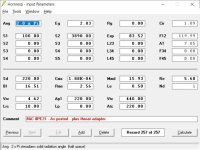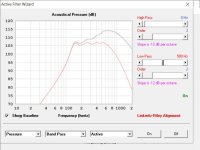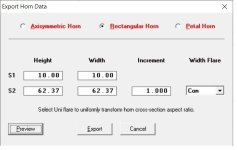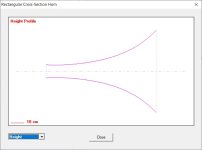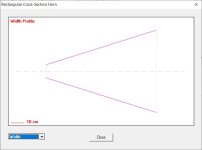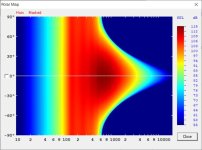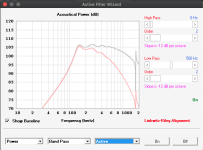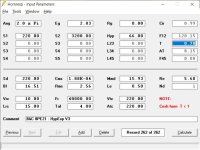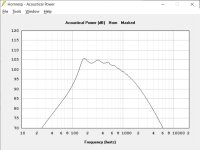Thanks for posting that. I've made one refinement (throat adapter), as I see the driver opening restricted to increase compression. The throat adapter is described by [AP1, ATC, VTC] and its a simple shallow cylinder 2cm deep. It makes very little difference, unless you had intended something else.
I'm providing the following pics, based on your design (V1), just to make sure we're on the same page. The power response is flat but the on axis SPL will be rising as the beamwidth narrows, and I've added a LR2@500hz but the actual XO point (-6dB) will be at a higher freq. The horizontal profile has the flare, and the vertical profile is conical, actually reversed from the hornresp titles.
I'm providing the following pics, based on your design (V1), just to make sure we're on the same page. The power response is flat but the on axis SPL will be rising as the beamwidth narrows, and I've added a LR2@500hz but the actual XO point (-6dB) will be at a higher freq. The horizontal profile has the flare, and the vertical profile is conical, actually reversed from the hornresp titles.
Attachments
The horizontal profile has the flare, and the vertical profile is conical, actually reversed from the hornresp titles.
The next update will make it possible to switch between "Width Flare" and "Height Flare" by double-clicking on the label.
The driver Sd=220, but the horn S1=100 so there is some kind of throat plate to cause that reduction. This is modelled as a throat adapter. The aspect ratio of the S1 opening can be adjusted in the export window.@DonVK Thanks so much for that!
What is the purpose of the throat adapter? Is that what causes the rising SPL curve you posted on the filter wizard?
The rising SPL is caused by the horn's beamwidth narrowing as freq increases. If power is relatively constant, and you narrow the beamwidth, the SPL will increase. This behaviour is a function of the horn dimensions and flare rate. You mentioned earlier that you would XO to a midrange tractrix, so matching (approximately) the beamwidths at midrange XO is also desirable.
Attachments
After you press calculate response, switch between acoustic power and acoustic pressure using [ctrl][x] and set the angle to 0 deg (on axis).
"I am wondering if it would make sense make the throat slightly rectangular (9.9cm x 10.1cm) instead of square to avoid the pinching."
You can make it lots rectangular. e.g. 8x13cm is fine. I've gone with 2:1 ratio and not noticed any problem.
I started doing rectangular throats to avoind the "pinch" (also known as "goosenecking"), and I kept on doing it because it seems to give smoother / more extended HF response.
e.g. in post 63 in this thread, the throat is a rectangle (with filled in corners).
https://www.diyaudio.com/community/threads/artichoke-horn.298525/page-4
You can make it lots rectangular. e.g. 8x13cm is fine. I've gone with 2:1 ratio and not noticed any problem.
I started doing rectangular throats to avoind the "pinch" (also known as "goosenecking"), and I kept on doing it because it seems to give smoother / more extended HF response.
e.g. in post 63 in this thread, the throat is a rectangle (with filled in corners).
https://www.diyaudio.com/community/threads/artichoke-horn.298525/page-4
@hollowboy that is good to hear. I guess there are lots of examples that use a rectangular thought. VOTT is the one that comes to mind
https://volvotreter.de/downloads/Edgar-Midrange-Horn.pdf
Figure 21a vs 21b
a is 2" x 2"
b is 4" x 2.5"
It is not apples-to-apples (b is also shorter) but b gives another 1kHz of flat response before it rolls off.
I've observed this same additional HF bandwidth in some of my tests ...and not in others.
Figure 21a vs 21b
a is 2" x 2"
b is 4" x 2.5"
It is not apples-to-apples (b is also shorter) but b gives another 1kHz of flat response before it rolls off.
I've observed this same additional HF bandwidth in some of my tests ...and not in others.
@hollowboy Thanks for the link. Have you observed any negative outcomes with rectangular vs square in your tests?
The most negative outcome I've had was laborously turning a quick prototype (square throat) into a relatively polished "final" build (rectangular throat) ...for no measurable difference at all. It wasn't worse - just a waste of time.
Note: I'm not great at record keeping, so I don't remember exactly which horn / driver this disappointment happened with.
My take away from this would be to suggest making a couple of super rough prototypes out of junk before you launch into the final build,
e.g. make a couple of plywood mounting plates for the drivers, slap together some rough horns from 4mm ply - or even sturdy cardboard (a couple of removalist boxes + a roll of duct tape). Make any floppy bits rigid by laminating a couple of layers of material together. The result should be rigid enough to be valid for tests.
Good inspiration:
http://doityourselfaudio.blogspot.com/2013/05/140hz-petal-horns.html
I've used this idea (holding the initial build together with cable ties) to quickly prototype a synergy-style horn.
Note: I'm not great at record keeping, so I don't remember exactly which horn / driver this disappointment happened with.
My take away from this would be to suggest making a couple of super rough prototypes out of junk before you launch into the final build,
e.g. make a couple of plywood mounting plates for the drivers, slap together some rough horns from 4mm ply - or even sturdy cardboard (a couple of removalist boxes + a roll of duct tape). Make any floppy bits rigid by laminating a couple of layers of material together. The result should be rigid enough to be valid for tests.
Good inspiration:
http://doityourselfaudio.blogspot.com/2013/05/140hz-petal-horns.html
I've used this idea (holding the initial build together with cable ties) to quickly prototype a synergy-style horn.
Of course, as stated by @hollowboy , and with an aspect ratio within reason. There may be some minor polar differences at higher freq (500Hz) but to see them requires a BEM sim.@DonVK thanks. I am wondering if it would make sense make the throat slightly rectangular (9.9cm x 10.1cm) instead of square to avoid the pinching. would the throat shape make a difference acoustically?
The throat plate will increase sensitivity and output, but the tradeoff is a longer horn for a given flare rate and cutoff. If the horn starts with a larger throat (S1=Sd) it can be made shorter but sensitivity is lower as well. Hypex curve allows a bit more tuning flexibility via T parameter.
Attachments
In many cases hornresp can clue us in to what's going on in unusual circumstances. Sometimes it takes a little thinking outside the box.but to see them requires a BEM sim.
The next update will make it possible to switch between "Width Flare" and "Height Flare" by double-clicking on the label.
The update has now been released:
https://www.diyaudio.com/community/threads/hornresp.119854/page-680#post-7361878
- Home
- Loudspeakers
- Multi-Way
- Rectangular horn orientation
